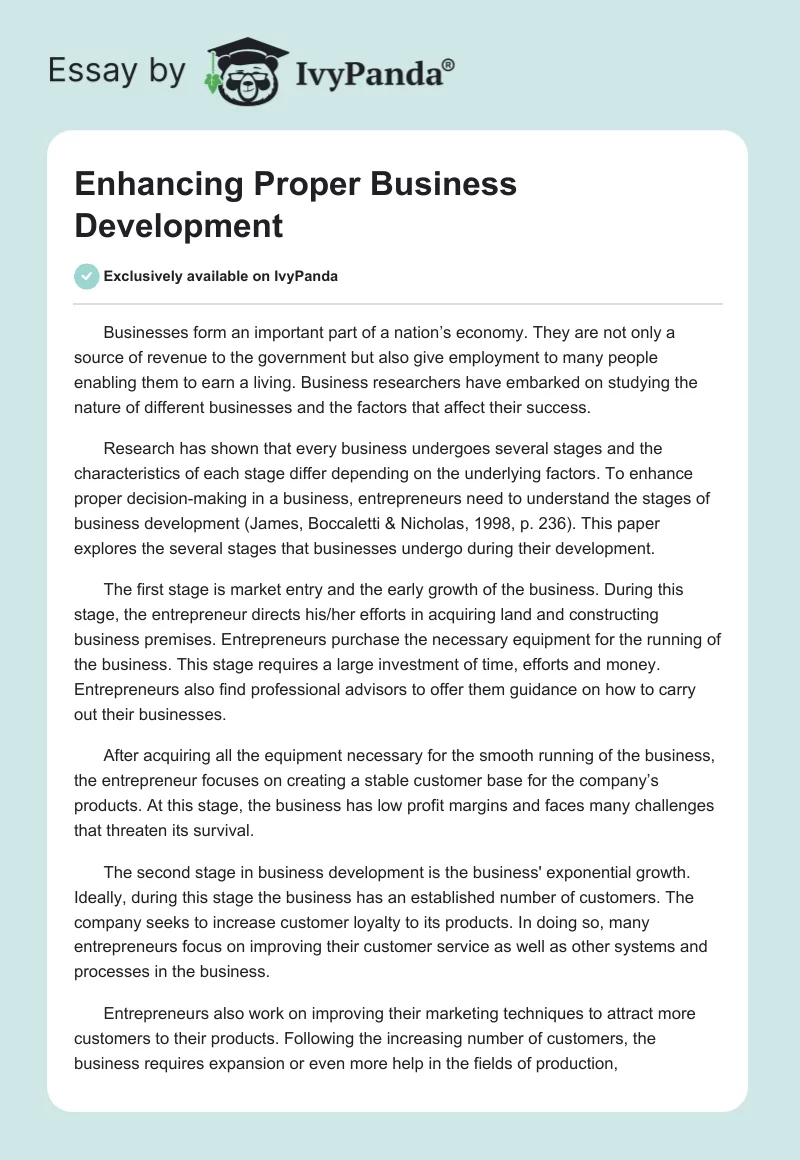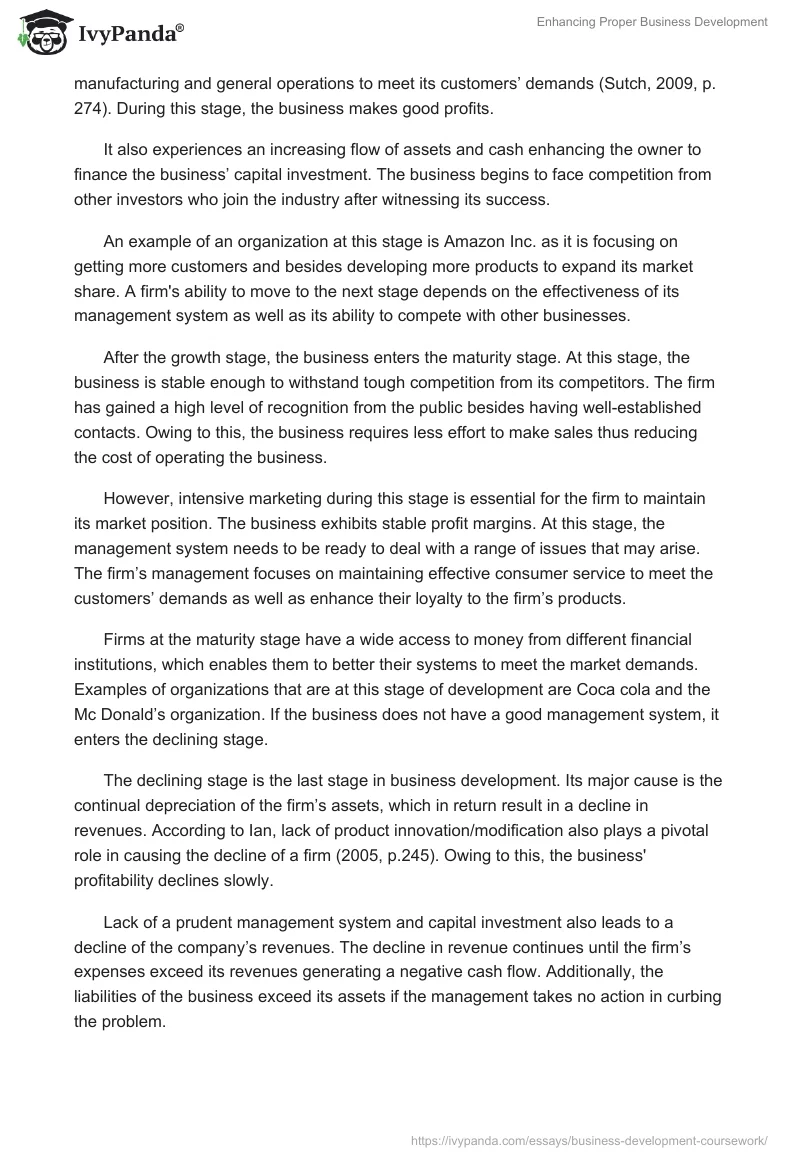Businesses form an important part of a nation’s economy. They are not only a source of revenue to the government but also give employment to many people enabling them to earn a living. Business researchers have embarked on studying the nature of different businesses and the factors that affect their success.
Research has shown that every business undergoes several stages and the characteristics of each stage differ depending on the underlying factors. To enhance proper decision-making in a business, entrepreneurs need to understand the stages of business development (James, Boccaletti & Nicholas, 1998, p. 236). This paper explores the several stages that businesses undergo during their development.
The first stage is market entry and the early growth of the business. During this stage, the entrepreneur directs his/her efforts in acquiring land and constructing business premises. Entrepreneurs purchase the necessary equipment for the running of the business. This stage requires a large investment of time, efforts and money. Entrepreneurs also find professional advisors to offer them guidance on how to carry out their businesses.
After acquiring all the equipment necessary for the smooth running of the business, the entrepreneur focuses on creating a stable customer base for the company’s products. At this stage, the business has low profit margins and faces many challenges that threaten its survival.
The second stage in business development is the business’ exponential growth. Ideally, during this stage the business has an established number of customers. The company seeks to increase customer loyalty to its products. In doing so, many entrepreneurs focus on improving their customer service as well as other systems and processes in the business.
Entrepreneurs also work on improving their marketing techniques to attract more customers to their products. Following the increasing number of customers, the business requires expansion or even more help in the fields of production, manufacturing and general operations to meet its customers’ demands (Sutch, 2009, p. 274). During this stage, the business makes good profits.
It also experiences an increasing flow of assets and cash enhancing the owner to finance the business’ capital investment. The business begins to face competition from other investors who join the industry after witnessing its success.
An example of an organization at this stage is Amazon Inc. as it is focusing on getting more customers and besides developing more products to expand its market share. A firm’s ability to move to the next stage depends on the effectiveness of its management system as well as its ability to compete with other businesses.
After the growth stage, the business enters the maturity stage. At this stage, the business is stable enough to withstand tough competition from its competitors. The firm has gained a high level of recognition from the public besides having well-established contacts. Owing to this, the business requires less effort to make sales thus reducing the cost of operating the business.
However, intensive marketing during this stage is essential for the firm to maintain its market position. The business exhibits stable profit margins. At this stage, the management system needs to be ready to deal with a range of issues that may arise. The firm’s management focuses on maintaining effective consumer service to meet the customers’ demands as well as enhance their loyalty to the firm’s products.
Firms at the maturity stage have a wide access to money from different financial institutions, which enables them to better their systems to meet the market demands. Examples of organizations that are at this stage of development are Coca cola and the Mc Donald’s organization. If the business does not have a good management system, it enters the declining stage.
The declining stage is the last stage in business development. Its major cause is the continual depreciation of the firm’s assets, which in return result in a decline in revenues. According to Ian, lack of product innovation/modification also plays a pivotal role in causing the decline of a firm (2005, p.245). Owing to this, the business’ profitability declines slowly.
Lack of a prudent management system and capital investment also leads to a decline of the company’s revenues. The decline in revenue continues until the firm’s expenses exceed its revenues generating a negative cash flow. Additionally, the liabilities of the business exceed its assets if the management takes no action in curbing the problem.
In the extreme cases, this leads to the collapse of a business. However, the management can take some measures to prevent the business from collapsing (Ian, 2005, p. 250). Such measures may include changes in the firm’s pricing and marketing systems.
The management may also work on improving its customer service systems. Repairing or even replacing the worn out equipment in the firm is also fundamental in restoring the firm’s efficiency and productivity.
In conclusion, there are four main stages of business development. They include the market entry and the early growth stage, the business’ exponential growth, maturity stage and the decline stage. The stages generally follow the same order though some business organizations may not experience the four stages.
The duration that firms take in each of the stages may vary depending on the effectiveness of the management system. These stages are important as they help entrepreneurs to make informed decisions depending on the stage of their business organization.
References
Ian, H. (2005). Risk, Perception Focus: A Real Cycle of the Entrepreneur. Australian Economic History Review, 45(3), 244-272.
James, F., Boccaletti, E., & Nicholas, T. (1998). Entrepreneurs and Business Performance in the Nineteenth Century France. European Review of Economic History, 2, 235-262.
Sutch, R. (2009). All Things Reconsidered: The Lifecycle Perspective and the Third Task of Economic History. The Journal of Economic History, 51(2), 271-288.


